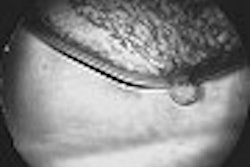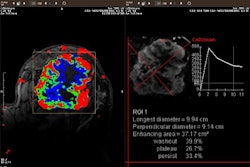By rearranging their practice so that all mammograms were read by breast imaging specialists at a central location, radiologists from the Brown University School of Medicine in Providence, RI, increased efficiency and saw a downturn in the callback rate.
Dr. Martha Mainiero and colleagues set out to compare the callback rates, as well as the number of additional breast imaging exams ordered, of mammography experts versus general radiologists.
Previous studies have shown that having mammograms read by specialists results in a lower recall rate and a higher cancer detection rate, Mainiero said in a presentation at the 2003 American Roentgen Ray Society meeting in San Diego. In addition, the experience level that seems to influence reading outcomes is the number of mammograms read per year, not the number of years the radiologists have been reading them, she said.
"The problem we found with our practice is that we have a lot of sites to cover," she said. "We have three hospitals and five outpatient offices, all of which do mammography. These are all located in about a 20-mile radius. We have 40 (radiologists), but of those physicians, 37 are between five offices. Starting in 2002, what we decided to do was to subspecialize our office practice."
During a seven-month period (September 2000 to March 2001), a total of 12,740 screening mammograms were performed and interpreted by specialists and general radiologists at the different sites. These data were compared to another seven-month stretch (September 2001 to March 2002), during which time 11,671 screening mammograms were performed at the various sites, but were all interpreted at a central location by 11 radiologists with expertise in breast imaging. The latter were considered experts if they read more than 2,000 mammograms annually, Mainiero said.
The number of screening mammograms, diagnostic mammograms, additional views, call-back rates, and ordered breast ultrasounds were compared between the two groups.
According to the results, the total number of screening mammograms performed in the two time periods were similar: 12,740 by the combined group, 11,671 by the specialists. However, statistically significant differences were found in other areas. The number of diagnostic mammograms came in at 2,309 for the general radiologists, compared to 839 when only specialists did the reading.
Patients were called back for additional imaging by the general readers in 1,259 cases. That figure declined to 875 for the breast imaging experts.
"In the first year overall, 11% of our patients had to come back for additional views. In the second year after we changed over to our breast imaging center, 9% of our patients had to come back for additional views. And that rate was statistically significant," she said.
The combined group ordered up 2,388 breast ultrasound exams, while the specialists requested 1,678. The average callback rate for the general readers was 12.2%, which was higher than the specialists’ rate of 8.8%.
"In the first year, BI-RADS Cat 3 mammograms were recommended for a six-month follow-up after a diagnostic mammogram," Mainiero said. "We did 2,309 diagnostic mammograms, and 36% were recommended for six-month follow-up. In the second year, the rate dropped to 15.8%."
The group concluded that they were able to improve their breast imaging practice by logging fewer recalls and follow-ups, Mainiero said. In addition, the non-breast imagers said that they felt their efficiency increased if they were able to concentrate on their areas of expertise rather than having to read mammograms.
But a drop in the number of screening mammograms conducted was a side effect of streamlining the process.
"Although this wasn’t an intended consequence, it wasn’t unexpected because we knew we were going from five radiologists every day in those offices reading mammograms to having one radiologist," she said. "We had to decrease the number of screening slots available and bring it to a level that could be accommodated by one radiologist a day."
This change resulted in a 4-6-month wait for patients undergoing screening mammograms, she said. Prior to the change, there had been no wait list. Also, because all diagnostic exams were done at one central location, Mainiero hypothesized that some patients opted out because they did not want to make the trip.
However, patients were given the option of being referred to one of the three hospitals where there was no waiting period, Mainiero explained in an e-mail to AuntMinnie.com.
"Some patients chose to wait and some chose to go elsewhere, including to our hospital practices. I don't believe that no-shows or cancellations were a problem," she said. "As we had the ability to offer patients screening with no wait at nearby hospital facilities, we did not feel that we were compromising patient access to mammography in our quest to increase efficiency."
This configuration is now in place permanently at the office sites, and Mainiero said that their practice continues to improve.
"Since the close of the study, we have increased the number of mammograms we do per day at all sites, and the wait time for a screening study has decreased to 1-3 months (depending upon the site)," she said. "Diagnostic mammograms are, as always, accommodated immediately."
By Shalmali PalAuntMinnie.com staff writer
July 28, 2003
Related Reading
Radiology residents not interested in reading mammograms, June 9, 2003
Radiologists say training, not tests, will hone mammography skills, April 10, 2003
Lawmakers mull mandatory testing of radiologists' skills in reading mammograms, April 8, 2003
Recently trained radiologists may interpret mammograms more accurately, February 27, 2003
Copyright © 2003 AuntMinnie.com



















